History of the American Look
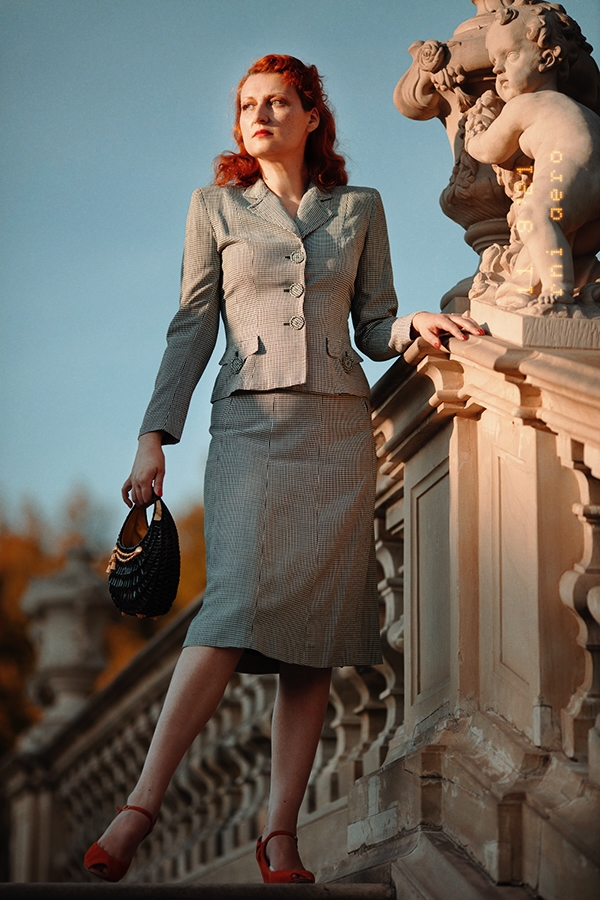
Last updated on March 21st, 2024 at 01:31 pm
- Sportswear Fashion & the American Look
- The Business of Being a Woman – The Fashions of American Women in 1912 and Lack of Original Designs.
- The Need for Distinctly American Style
- Original Parisian Designs Versus American Copy
- The Theft of Parisian Designs Began at Home
- A Very Brief History of The Fashion Group International Inc., founded in 1931
- Fashion is Spinach, by Elizabeth Hawes, 1938 -the leading figure in the American design movement.
- The Great Depression & Dorothy Shaver’s Master Plan to Promote American Designers
- The Great American Design Movement
- The American Design movement had to fall on its face in 1932.
- Dorothy Shaver Continued to Heavily Promote American Designers who Understood the Needs of American Women & their Active Lifestyle.
- Claire McCardell & the American Look
- Eleanor Lambert & the American Look
- The American Look Campaign
- What is The American Look?
- My Version of the American Look – Elegance Meets Comfort
- The 1940s sportswear
A brief history of The American Look
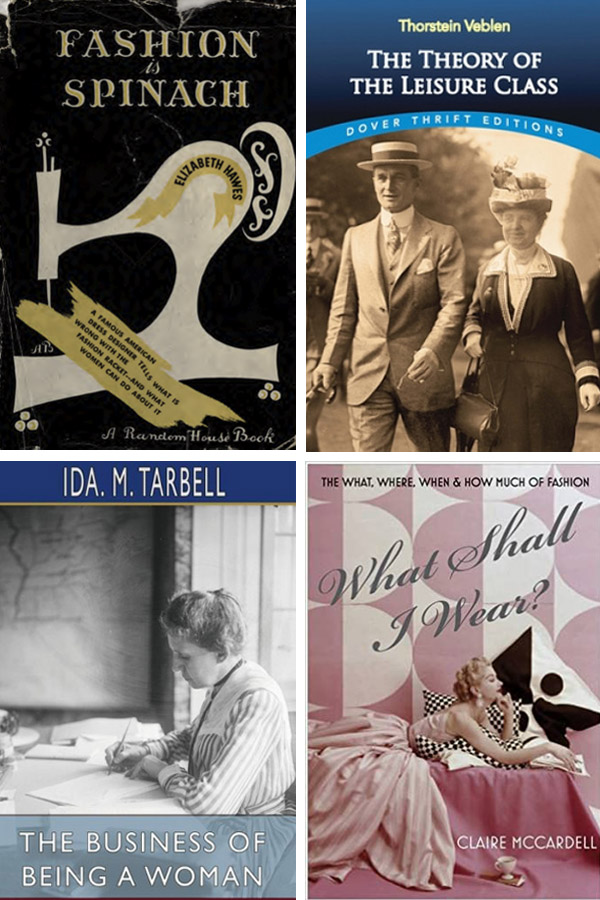
Have you ever found a book so fascinating on a topic, that it inspired you to follow up with another book and another until you fell down the rabbit hole of research? My journey began as a classic blue pill, red pill scenario.
Of course, I chose the latter. Four weeks, seven books, and copious amounts of coffee later, It’s been quite a journey, but now I believe that I can see the light. Clarity at last!
The topic of my research? The birth of the American style, or more specifically, the origins of the American Look.
Sportswear Fashion & the American Look
Anyone who is familiar with fashion history will be aware of what I’m talking about, Wikipedia describes it under the title of “Sportwear fashion”.
But obviously, there’s a lot more to it than that and many, many volumes were written that go into far greater detail. Trust me, I know!
What I wanted to share with you though, is my condensed version of its history, for the most part by using direct quotes from the source material and it’s that source material that I hope you’ll follow up with, like me, into the rabbit hole. Before continuing though, I’ll headline this with a warning.
After reading the books from my recommended list, you will never look at American and French fashion the same way again. So, proceed at your peril!
The Business of Being a Woman – The Fashions of American Women in 1912 and Lack of Original Designs.
My journey started with a brilliant find; The Business of Being a Woman, by Ida.M Tarbell, 1921. This book included an article written by Ida, who was a writer, muckraking journalist and lecturer, that first appeared in the August 1912 edition of The American Magazine, and was later published in her riveting book under the chapter; “The Woman and her Raiment.”
The Woman and her Raiment
There are certain industrial and ethical results from this preoccupation with clothes which should not be overlooked, particularly the indifference to quality which it has engendered. The very heart of the question of clothes of the American woman is imitation. That is, we are not engaged in an effort to work out individuality. We are not engaged in an effort to find costumes which by their expression of the taste and the spirit of this people can be fixed upon as appropriate American costumes, something of our own. From top to bottom we are copying. The woman of wealth goes to Paris and Vienna for the real masterpieces in a season’s wardrobe. The great dressmakers and milliners go to the same cities for their models. Those who cannot go abroad to seek inspiration and ideas copy those who have gone or the fashion plates they import. (…) From start to finish it is imitation, and on this imitation vast industries are built—imitations of silk, of velvet, of lace, of jewels. (…) We have failed so far to develop standards of taste, fitness, and quality, strong, sure, and good enough effectually to impose themselves. There is no national taste in dress; there is only admirable skill in adapting fashions made in other countries. (…) The very general adoption of the ugly and meaningless fashions of the last few years—peach-basket hats, hobble skirts, slippers for the street—is a case in point. From every side this is bad—defeating its own purpose—corrupting national taste and wasting national substance
Ida.M Tarbell
The Need for Distinctly American Style
The separation from Parisian influence.
As early as 1912, there was an overwhelming need for a distinctly American style and separation from what was perceived as a foreign influence on fashion. Not so much on the part of the American female buyers who didn’t know better, but rather the American female visionaries working in the fashion industry.

Original Parisian Designs Versus American Copy
A Very Brief History of Fashion Copying in Paris and NYC from the 19th century till the 1950s.
- Design piracy/theft in fashion, haute couture and even ready-to-wear is nothing new, it’s as old as the sewing machine itself (1846). Well, maybe not quite as old, but it definitely helped, and further technical developments of the early 1900s in ready-to-wear clothing, made it easier and faster to copy original designs, most desirably the ones from the best Parisian couture houses.
- Interestingly, In France, the law protected and still does, its designers who are considered artists. In the U.S.A. the law protects the copyist.
- France had two associations protecting fashion designers.
- The Chambre syndcale de la couture parisienne.
- PAIS-The French association protection artistique de industries saisonnieres was founded in 1923, by the couturiere Madeleine Vionnet. She was very prolific in taking to court anyone who dared copy her designs. Vionnet photographed all her models and put a date and serial number on each picture. She also created a logo and signature that helped with proofing the garment’s authenticity.
- America, on the other hand, had the Fashion Originators Guild of America.
F.O.G.A. was founded in 1932 by one of the biggest clothing manufacturers, Maurice Rentner and his lawyer Sylvan Gotshal. The concept behind this trade organization which consisted of manufacturers and retailers, but not designers, was, in a nutshell, to protect dress manufacturers from being copied. F.O.G.A’s members vowed to create and sell only original designs. If they were caught breaking that rule, they would get a red card which meant that other F.O.G.A. members were prohibited from doing any type of business with them. As you can imagine, that did not go well with many of the retailers who thought it to be unfair.
In 1941, the Supreme Court decided that F.O.G.A. violated the Sherman Antitrust Act and was banned from continuing with their anti-design piracy work.
*Fun Fact! Maurice Rentner was notorious for copying French designs and made a fortune from doing so.
First Thing First. What is a Couturier?
Properly speaking, a couturier or couturiere, male or female of the species, is a person who creates clothes for individual women and maintains an establishment where those designs are sold directly to women and made to order. All important couturiers show at least two collections of clothes a year, spring and summer clothes in February, autumn and winter clothes in August or September. (…) They design beautiful clothes for rich and beautiful women, and what the rest of the French population wears is of no importance. It is not only of no importance to the French designer, it is of no importance to anyone in the fashion world. The entire French legend is built upon a few designers who design for a small group of a few hundred or possibly a few thousand women who are “chic.
Hawes, Elizabeth. Fashion is Spinach.1938, p.14 and 18.
Charles Frederick Worth is considered the Father of Haute Couture. He founded his haute couture house in 1857.
The Theft of Parisian Designs Began at Home
I am sure that wherever important couturiers have flourished in sufficient numbers to warrant attention, there have been copy houses. Certainly, when I was in Paris in 1925 there were plenty of them, and they still continue on their illegitimate way.
Hawes, Elizabeth. Fashion is Spinach.1938, p.38.
Only a small percentage of Parisians could afford haute couture prices, so a copy of the original design was the only option for those who wished to look chic, but their purse did not match their taste.
The best copy houses in Paris made their clothes in the exact same fabric, with the exact same trimmings, as the original design which was reflected in the very high price of the exquisite copy.
Interesting fact, some of the copy houses bought the original models and then made copies of them. Others paid handsomely to sketchers attending fashion shows per sketch. Sometimes they borrowed, for a fee, of course, original pieces from clients who wanted to recoup some of the money they spent on their lavishly expensive haute couture.
In other words, buy, borrow, steal.
- Copying was illegal in France and the punishment was dependent on the number of times a copy house was caught red-handed.
- First-time offenders received a fine, but if caught again, they could face going to prison for up to six months.
In France, a couturier could protect their fashion business by;
- Obtaining a patent for their designs.
- Copyright their designs and their brand.
- Apply for a trademark.
Sadly, in the U.S.A. the matter was handled very differently, as copyright law did not cover fashion designs.
- A designer in America could patent an innovation.
- Apply for a trademark for their brand and logo.
The lack of protection of fashion designs meant that those who spent a fortune on buying original Paris couture and the right to reproduce it could legally be copied by every manufacturer in the U.S.
Illegal Copies of Christian Dior Designs. Sue, Sue, Sue!
In 1948*, several haute couture designers including; Christian Dior, Jeanne Lanvin, Molyneux, Pierre Balmain and Jacques Fath sued Wolfson & Greenbaum, an American manufacturer, for stealing their designs and using labels with the French designers’ names suggesting that those were in fact originals!
*August 16, 1948, Section BUSINESS BUYERS WANTS-OFFERINGS TO BUYERS, Page 23 New York Times.
Believe it or not, the couturiers won! Unfortunately, thousands of knock-offs had already been in circulation.
*Over the years, I’ve seen several cheap copies of Dior dresses. They had two things in common, they were made of cotton and they had flower prints on them. Buyers, be aware!
Christian Dior and His Designs for the American Market.
“Money Makes The World Go Round.”
Dior and Fath realised that there was a lot of money to be made selling cheaper garments so they started their American prêt-a-porter adventure by creating more affordable lines than haute couture.
If you come across a vintage gown with the Jaques Fath Originals label, you will know that it was for the American mass market.
A Very Brief History of The Fashion Group International Inc., founded in 1931
The Fashion Group International Inc. was the leading women’s professional organization in the American fashion industry.
(From Archives of the New York Public Library)
- In 1928, 17 professional women in the fashion industry, gathered by Edna Woolman Chase, Editor-In-Chief of Vogue met in New York City at the Mary Elizabeth Tea Room to talk about the plans and mission for a club.
- In 1930, the Fashion Group is incorporated, with by-laws, a purpose and an official mission statement.
“The Fashion Group is a national noncommercial association of women engaged in fashion work, formed to advance the principles of applied art in industry and to foster good taste in fashions; to encourage the cooperation of those engaged in conceiving, designing, and executing fashions; and, through education and the dissemination of useful information, to inspire a keener interest in fashion industries, to the end that those engaged in the field of fashion may better serve themselves and the public at large.”
Founding members of the Fashion Group
Elizabeth Arden, Margaret Case, Eleanor Roosevelt, Helena Rubinstein, Julia Coburn, Lily Dache, Jessica Daves, Nan Duskin, Edith Head, Claire McCardel, Clare Potter, Virginia Pope, Dorothy Shaver, Adele Simpson, Carmel Snow, Miss Tobe.
- In 1931 Placement bureau was established. The number of members is growing and by the end of the year, it comes to 375.
- From 1932 onwards, Regional Fashion Groups were established. Cleveland, Chicago, Los Angeles, San Francisco etc.
- In 1935 the first “Fashion Futures” show presented the best trends from Paris.
- 1954 – the year that the Anual Fashion Training Course was established.
- In 1956 Paris became the first Regional Group established outside the USA.
- Finally, in 1957 scholarship fund was established
Fashion is Spinach, by Elizabeth Hawes, 1938 -the leading figure in the American design movement.
If you are interested in the topic of American fashion and have time to read only one book at the moment, “Fashion is Spinach” is the one to choose from. Elizabeth Hawes was a successful American designer and a brilliant writer. She was one of the biggest critics of the Parisian style. Having worked there as a copyist of French couture designs and learning the business inside and out, she challenged French fashion supremacy. Most importantly, Hawes helped to shift the centre of the fashion industry from Paris to NYC. Again, I’ll select a few choice highlights from it to share with you.
Ready-To-Made versus Haute Couture
“There are only two kinds of women in the world of clothing. One buys her clothes made-to-order, the other buys her clothes ready-made. Fashion is a parasite on style. Without style, he wouldn’t exist, but what he does to it is nobody’s business. Fashion is that horrid little man with an evil eye who tells you that your last winter’s coat may be in perfect physical condition, but you can’t wear it. You can’t wear it because it has a belt and this year “we are not showing belts. (…)
The catch was, of course, that although this was apparent in France where there were many designers working out their new ideas and trying them out slowly, in America there were practically no designers. And the American buyers were funny people. They always bought the new version of what they had already seen the season before. They never even looked at the really new things. Manufacturers and department stores are not in business to experiment. They are in business to make money. In the realm of clothes, they are very happy to have the French couturier experiment.”
The Great Depression & Dorothy Shaver’s Master Plan to Promote American Designers

“While men may have set out with disapproving an inexpensive manner of living because it indicated an inability to spend much, and so indicated a lack of pecuniary success, they end by falling into the habit of disapproving cheap things as being intrinsically dishonourable or unworthy because they are cheap. ”
“A cheap coat makes a cheap man,” The Theory of the Leisure Class, by Thorstein Veblen, 1899.
Well, Veblen was right to say; “A cheap coat makes a cheap man,” but the Great Depression saw a drop in sales and a general change in consumers’ attitudes towards shopping and parting with their hard-earned money.
- French models were expensive. An increase in duties meant that few in the fashion industry could afford to buy them. On top of that, copies of original designs were available to purchase for a fraction of the price. And that was all that mattered to women on a budget.
- Dorothy Shaver finally saw an opportunity to create an American fashion for American women, free of the Parisian influence. Shaver chose three American designers: Elizabeth Hawes, Annette Simpson, and Edith Reuss, to create beautiful yet comfortable and easy-to-care-for, mass-produced clothes for women on different budgets.
- It was the first and moderately successful attempt in creating American sportswear/leisurewear for active modern women who enjoyed outdoor activities. The concept of designer sportswear was not a new one. It originated in France in the 1920s, attributed to the two big rivals Jean Patou and Coco Chanel as its creators.
To quote Elizabeth Hawes in Fashion is Spinach yet again;
“Promoting American Designers was a press stunt for Lord and Taylor. There was the depression. They needed business. What to do? American Designers.”
Unfortunately, despite Shaver’s prowess as a brilliant PR and good press reception, Vogue insisted that Paris still ruled American fashion. Putting American designers on the map wasn’t an easy task, and up until Shaver’s “stunt” for Lord & Taylor no one has ever mentioned American designers by name. She was the first one to do so!
Why the press didn’t mention American fashion designers by their name?
“The New York newspapers developed a uniform policy of mentioning no American names at all in their fashion columns. They often use a little box advising the public to write in and ask where the articles or garments mentioned can be bought.
Sometimes they simply write up certain clothes or print pictures of them as general news without any possible identification of the source. The paper protects itself in this manner from the competitive jealousies of its advertisers and at the same time allows the fashion writer to talk about non-advertisers. ” Fashion is Spinach
The manufacturers were not keen on the idea either. They knew that it would give the overworked and often underpaid designer too much power.
The Great American Design Movement
“I reflected on the Great American Design movement, so blithely begun by Lord and Taylor in 1932. Now it was the spring of 1934 and one heard comparatively little of the American Designers. A good many people had originally insisted that there weren’t any.
Then, because Lord and Taylor told them and other stores promoted because dozens of articles were written on American Designers, everyone became convinced there must be some somewhere. And, in fact, myriads of people turned into American Designers who had never been seen before and have never been heard of since.
What had become of that widely hailed “means of stimulating business” in the dress industry? I’ll tell you what became of it. It simply wasn’t profitable. We were a promotion which was dropped because, after a while, either you must show a profit or go the way of all flesh.
The American Design movement had to fall on its face in 1932.
There just weren’t enough trained designers. The designers will learn, finally.
They will graduate more quickly from their infancy if the stores and manufacturers stop throwing France in their faces and will let them use the background God gave them. The designers will find out what the public wants if the stores will stop concentrating on promotions for a while and begin to worry about the specific needs of their clientele. (…) They(Lord and Taylor) promoted another set of American designers, Clare Potter and Muriel King. The promotions were widely publicized as well as advertised. A flood of articles on American Designers came out in newspapers and magazines all over the U. S. A. ” Fashion is Spinach
Dorothy Shaver Continued to Heavily Promote American Designers who Understood the Needs of American Women & their Active Lifestyle.
When the Germans occupied Paris, the USA was suddenly cut off from the capital of fashion. And that’s when NYC saw its chance to develop and cultivate the American style. Not to mention that shopping for American-made products was a patriotic thing to do during World War II.
In the first wave, we had names such as; Muriel King, Annette Simpson, Clare Potter, Nettie Rosenstein, Sally Milgrim, and Elizabeth Hawes.
Shaver was an unstoppable PR force who made sure that the name of every designer was in print. Thanks to her; Claire McCardell, Vera Maxwell, Adele Simpson, Jo Copeland, Tina Leser, Bonnie Cashin and Anne Fogarty were on everybody’s lips.
Claire McCardell & the American Look


My last but not least book recommendation is Claire McCardell’s little gem from 1956, entitled What Shall I Wear? In a nutshell, it’s the designer’s fashion philosophy and detailed guide on what to wear and what to avoid to look effortlessly chic. And even though the book was published 60 years ago, her advice is as current now as it was then.
“I think a closer look will tell you that one universal statment can be made about any well-dressed woman.” She has spent time on her clothes.” Not a lot of money necessarily. Not where she shops-nor whose label she wears. But time(plus energy and patience and imagination)-all her own.”
Eleanor Lambert & the American Look

Fun fact! Lambert was friends with Dorothy Parker, one of my favourite American poets, and one crazy night the two ladies decided to get a tattoo, which was pretty audacious in those days. Lambert chose to adorn her ankle with a little blue star. I would love to know what kind of body artwork Parker opted for.
- In 1941 she did the PR for the New York Dress Institute with the mission of promoting American designers and establishing New York City as the new fashion capital free of French influence.
- The New York Creation Label was formed under the New York Dress Institute to help achieve the mission.
- Lambert established, with the collaboration of Coty, Inc., the American Fashion Critics Awards with Norman Norell as its first recipient in 1943.
- And last but not least, in 1943, Lambert founded the Press Week. It’s thanks to her we can enjoy what is now known as the New York Fashion Week, so thank you, Eleanor!
The American Look Campaign
It was one of the most memorable and successful advertising campaigns in the 1940s created by Shaver to promote American fashion for American women. It was the birth of the American Style.
What is The American Look?
The American Look involves many things- a natural manner, freshness and enthusiasm, a friendly smile, an easy, confident stride with head held high, an unaffected elegance in make-up and dress. It’s that certain kind of American figure-long-legged, broad-shouldered, slim-waisted, high-bosomed.” On the pages that follow LIFE Photographer, Nina Leen translates these qualities into pictures.
LIFE magazine, 21 May 1945.
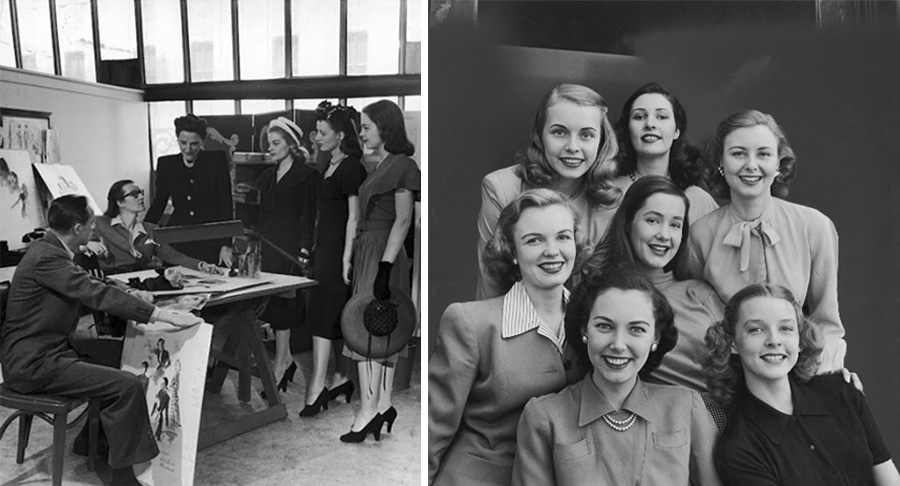




My Version of the American Look – Elegance Meets Comfort
One of my favourite American brands popular in the 1940s and 1950s is Handmacher. This 1940s black and green skirt suit is a new addition to my growing Handmacher collection and a perfect representation of the American Look.

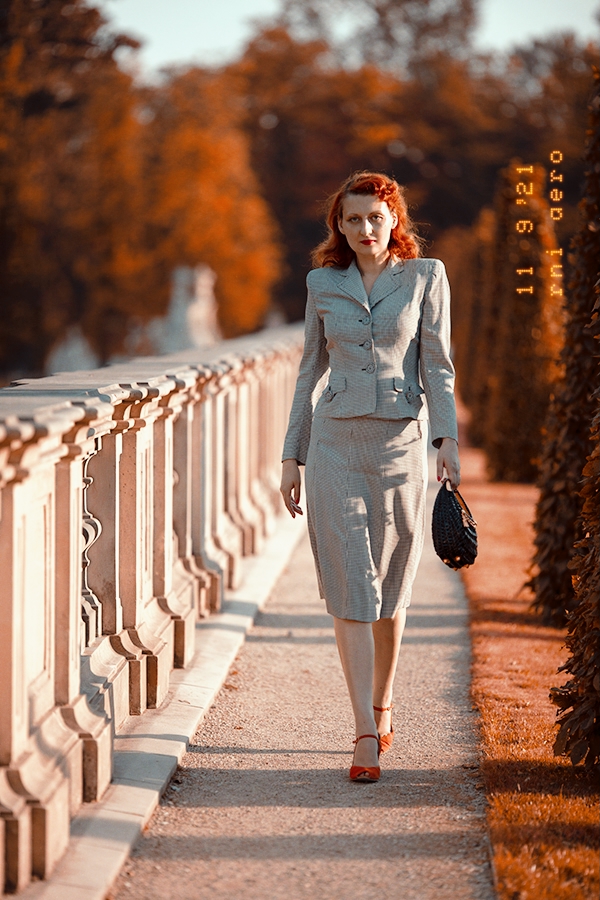
She walks erect, holds her head high and she is not nonplussed by the admiring glances or whistles that follow her.

The quintessential American wardrobe staple-the shirt dress!

Suits, separates, shirtwaist dresses-smartly tailored, cut for comfort-here are clothes that should be a mainstay in any wardrobe. They are gifted clothes that go round the clock-round the world with a distinguished air. (…) They are in tune with busy lives; commute well; look at home in the office, at the best restaurants, at the theater.
Claire McCardell in her book “What Shall I Wear?”
I’ve recently purchased this 1940s shirt dress that is officially one of the most comfortable and versatile garments I own, a must-have item described in 1942 by Sylvia Weaver, LA Times Fashion Editor, as a dress that fits the needs of a career woman. Be it business or leisure, a shirt dress will never disappoint or go out of style.
DISCLOSURE: As of October 2021, I’m part of an affiliate program, and I get a small commission for purchases made through links in the Shop My Favourites section. That’s how I keep my website alive, for which I’m very grateful to you. All opinions expressed here are mine!


SHOP MY FAVOURITE VINTAGE PIECES
The 1940s sportswear
And last but not least, an ensemble example without which an article about the American Look would be incomplete. The 1940s sportswear! I’ve been looking for a 1940s Koret of California Sportswear skirt suit for years now, and luck has it that I found a spectacular one quite recently.
I purchased this rare beauty from the listitcafe shop on Etsy. Christine has extraordinary taste and therefore you will find some fabulous vintage pieces in her shop!
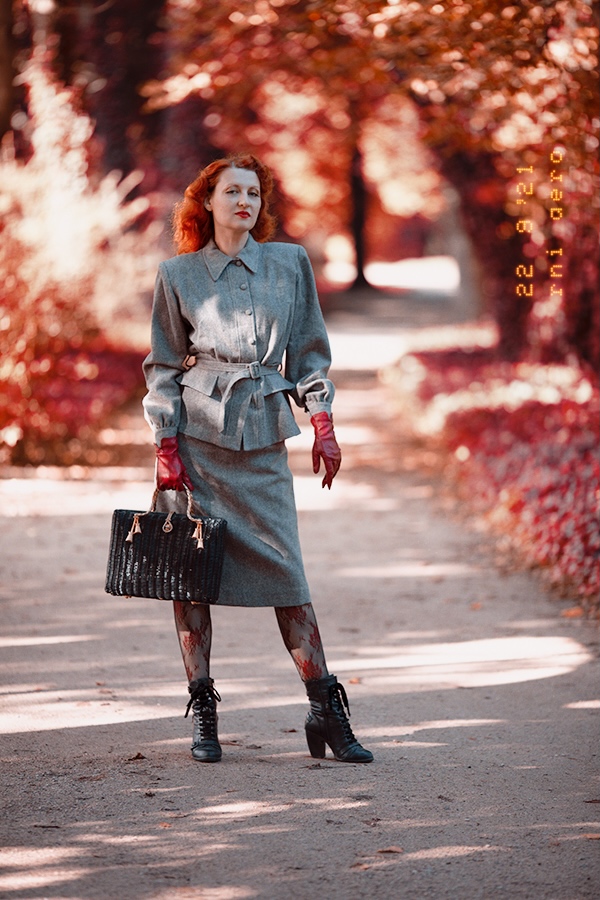
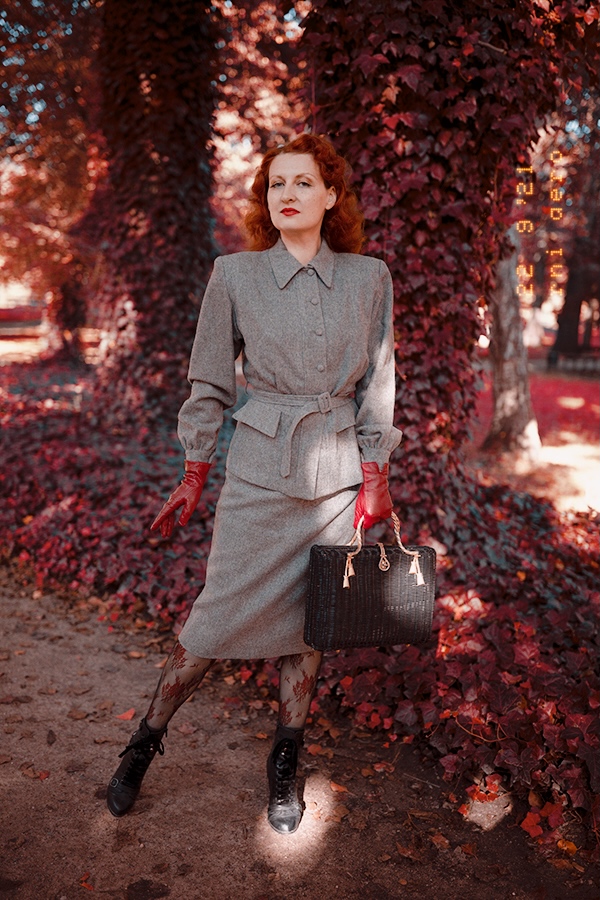

I hope you enjoyed my article about the American Look and my book recommendations. If you would like to show your support for my blog and help with further fashion history research, please donate to my book fund. Thank you!
Dominique x






